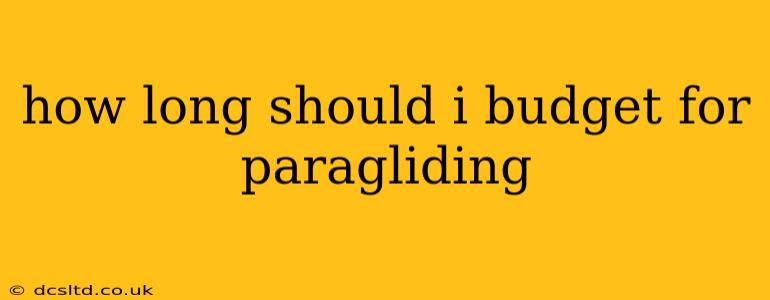How Long Should You Budget for Paragliding? A Comprehensive Guide
Paragliding is an exhilarating sport that offers breathtaking views and an unparalleled sense of freedom. But before you take to the skies, understanding the time commitment is crucial. The answer to "How long should I budget for paragliding?" isn't straightforward; it depends heavily on your goals and approach.
This guide breaks down the time investment required, addressing various aspects from initial training to achieving proficiency. We'll also tackle frequently asked questions to give you a complete picture.
How long does it take to learn to paraglide?
This is the most common question, and the answer varies widely. A typical paragliding course takes between 7 and 14 days, encompassing both ground school and flight training. The duration depends on factors like:
- Prior experience: Individuals with experience in other air sports or with a strong understanding of aviation concepts might learn faster.
- Learning aptitude: Like any skill, some individuals pick up paragliding more quickly than others.
- Weather conditions: Favorable weather is essential for training, and delays due to inclement weather can extend the training period.
- School intensity: Some schools offer intensive courses that pack a lot of training into a shorter period.
What's involved in paragliding training?
Paragliding training usually includes:
- Ground school: Theoretical instruction covering meteorology, safety procedures, equipment knowledge, and flight principles.
- Practical training: This involves hands-on experience with the paraglider, starting with ground handling (controlling the wing on the ground), followed by gradual progression to airborne flights.
- Solo flights: Once instructors deem you ready, you'll embark on solo flights, gradually increasing altitude and duration.
Beyond the initial course: How much time for ongoing practice?
Completing the initial course is just the beginning. To maintain and improve your skills, consistent practice is crucial. This could involve:
- Regular flying sessions: Ideally, you should aim for regular flights to maintain proficiency and build experience. The frequency depends on your personal goals and available time.
- Advanced training: Once comfortable with basic flight maneuvers, you can pursue advanced training in areas like acro (acrobatic flying), cross-country flying, or specific flying techniques. These courses can vary in duration, from a few days to several weeks.
- Practice with experienced pilots: Flying with more experienced pilots can accelerate your learning and provide valuable insights.
How long does it take to become proficient at paragliding?
Proficiency isn't a binary state; it's a continuous journey. You'll likely feel comfortable with basic flying within weeks of completing your initial course, but true mastery takes years of consistent flying and ongoing learning. Think of it like learning any challenging skill: dedication, time, and persistence are key to becoming truly proficient.
What about the time commitment for cross-country flying?
Cross-country paragliding, involving long-distance flights, requires a significant time investment. It demands extensive experience, exceptional skill, and detailed knowledge of meteorology and navigation. You'll need to invest time in:
- Advanced training courses specifically focused on cross-country techniques.
- Extensive practice flights to develop the necessary endurance and decision-making skills.
- Careful planning of flights, including studying weather patterns and choosing appropriate routes.
Can I paraglide on weekends only?
While you can progress with weekend-only flying, it'll likely take longer to reach your goals. Regular practice is crucial for skill retention and development. Weekends alone might be sufficient for casual enjoyment, but not for rapid progress toward advanced flying.
In summary, budgeting for paragliding involves considering the initial course duration (7-14 days), followed by an ongoing commitment of regular flying and potential advanced training depending on your aspirations. The time investment depends entirely on your objectives—from casual enjoyment to competitive cross-country flying. Be realistic about your time commitment, and remember that the journey itself is a rewarding experience.
